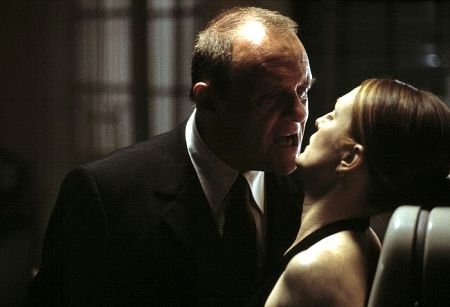In observance of that autumn spell when we celebrate the primal, compulsive instinct of fear, Rainestorm once more highlights 31 days of spooky scares to season the eerie atmosphere of Halloween.
For those who tuned in last year, I subjected you to a daily dose of diabolical dread and devilish distress. Just as every good horror movie deserves an inferior sequel, I offer this follow-up of also-rans, not bads, and perhaps a couple of you’ve-gotta-be-kidding-mes.
Unleashed: 2001

What evil lurks: You can keep your Silence of the Lambs. I’ll have none of it. Anthony Hopkins took a truly fascinating and authentically creepy sociopath and turned him into a farce, particularly when set against Jonathan Demme’s boilerplate police procedural. Fortunately, Ridley Scott came along and wrapped the character in a wonderfully tragic opera, giving the now legendary cannibal an appropriate outlet for his ostentatious theatrics. Though Jodie Foster’s absence is unfortunate, Julianne Moore ably steps in and, in some ways, exceeds Foster’s characterization. Clarice Starling is a veteran agent now and, rather than being Lecter’s pupil, she is his muse. Hannibal pushes the character through to a psychotically romantic conclusion. This film was astonishingly maligned for its violence and gore, as if audiences somehow collectively obliterated from their memories the body-pummeling, face-stealing brutality of the original. Even so, the violence and gore are never gratuitous. All of it is in service to the story and the characters. In keeping with his operatic vision, Scott gives the audience butchery as sophisticated art.
Highlight from hell: The infamous banquet scene, wherein the refined Dr. Lecter feeds the boorish Agent Krendler his own philistinism.
Terrifying trivia: Though only a portion of it is heard, composer Patrick Cassidy wrote an entire aria for the outdoor opera sequence in Florence.
Diabolical dialogue: “Bowels in… or bowels out?”
Son of: Peeping Tom (1960). Some have argued that it’s the first slasher film as it puts the audience in the killer’s point-of-view. That may be partly true. However, it’s more accurate to say that this is the first murder movie to use the killer as the protagonist, something it shares with Scott’s sequel.
Shoddy sequel syndrome: Ridley Scott’s affinity for changing shutter speeds and blurry camera pans and zooms appears to have begun with this film.


You must be logged in to post a comment.